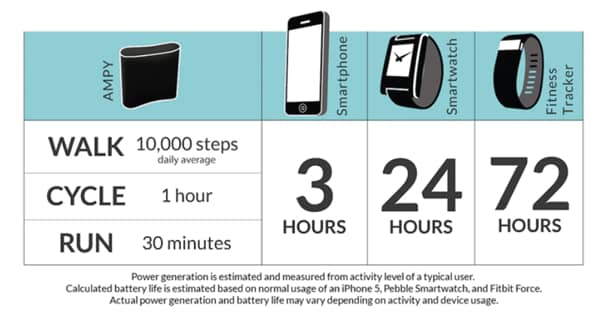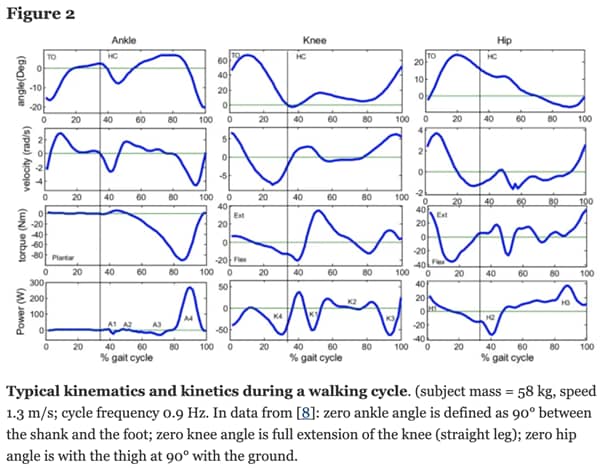How human movement & heat can sustain self-powered products.
Intimidating terms are often affiliated with a rather simple concept; converting human energy into usable power. Biomechanical energy harvesting, triboelectric nanogenerators, piezoelectric components, and porous nanocomposite fabric, just to name a few.
Even the word “harvesting” carries an unfortunately negative connotation. All of these terms stem from research conducted in our human quest to find cleaner, greener, energy sources.
By walking, swinging your arms, wearing specially-designed boots, or simply producing body heat, you maintain the ability to avoid traditionally battery-reliant products. It may be surprising this is not only an idea, but a developing market as well.
For example, the company PowerWatch exclusively sells smart activity watches powered by their one-of-a-kind thermoelectric engine. This means it uses your body heat produced to power the watch. Not only is it the first watch of its kind, it’s green, it’s stylish, water-resistant, includes a GPS, activity tracker, and more. No batteries required!
There is also SolePower, work boot producers that use kinetic energy to fuel low-power sensors, such as GPS. Let’s not forget about AMPY, a wearable/carriable pack that reaches full charge with 10,000 steps a day, or a cycling workout. This pack can then charge up your phone, smartwatch, or fitness tracker with a simple USB plugin.
How it Works
After experiencing feelings of excitement, shock, and awe, there are natural questions that arise. How does this work? How green is it? How can this be implemented into everyday life?
Human motion and heat generate energy. A portion of this energy is considered to be convertible, and the rest is ‘lost’ to the natural brakes of the human body. This energy is captured, and then converted to usable energy equivalent to a battery. This is done with the aid of advanced biomechanical energy harvesting devices and energy conversion methods.
According to the Journal of NeuroEngineering and Rehabilitation, “the maximum amount of energy that can be harvested is approximately 1 W per kilogram of device weight. For a person weighing 80 kg and walking at approximately 4 km/h, the power generation from the heel strike is approximately 2 Watts -W. For a joint-mounted device based on generative braking, the joints generating the most power are the knees (34 W) and the ankles (20 W).”
To put this in perspective, 1 W is enough to power a smaller prosthetic device (for example, Proprio Foot). However, 34 W is enough to charge your phone!
The successful conversion of human energy to electrical energy is vital, and has real-time application. It can and does reduce battery demand, hence reduce battery-usage, subsequently mitigating the harmful impact batteries (and their production) have on the environment. For example, computerized prosthetics do require recharging.
With new and innovatively designed prosthetics, the movement of the human body can recharge them, without the need for an electrical power source, such as an electrical socket. Apart from the immense benefit of this energy being as green as it gets, this allows those who use prosthetics to do more, such as take long hikes. It’s no secret that power outlets aren’t readily available in nature.
Practical Implementation
It’s time to discuss how to utilize these amazing innovations in everyday life. It may seem overwhelming at first glance, but a keen eye and a desire to be green go a long way. Myriad research and an increasing amount of products are taking advantage of this science.
Ask yourself the following questions:
- Do I have a phone that requires charging? If so, would I consider charging it with a kinetic energy-converter product?
- Do I have a rechargeable, battery-powered smart watch? Should I consider switching to a self-sustainable activity watch instead?
- Do I wear boots for work (or for fun)? If so, is it worth investing in shoes that convert my energy?
The success and growth of this market is not only research and development, but consumer demand for sustainable and green everyday products. If you have a phone, wear a watch, and/or wear shoes, consider investing in a greener option rather than your go-to, less eco-friendly habitual purchases. With increased demand, an increase in options, innovation, and cleaner products of all kinds will follow suit.
Is it Worth it?
As with all changes made in daily life, it can be difficult to remember to stay on track. By making simple adjustments, such as throwing your AMPY in your bag before you walk or cycle to work, you can lessen the detrimental impact of batteries. With the rise in product options and availability, the responsibility of the consumer also shifts in tandem.
A greater awareness of options inevitably drives consumerism.
Eco-friendly product users are the driving force behind the steps towards self-realized market awareness, and a step away from simply being told what is available.
What now?
- Stay in the know by subscribing to company newsletters! While not many of us are keen for even more emails, it is important to hear from the companies at the frontier; their new products, new ideas, and even new competitive prices as more players enter the game.
- Purchase these products if you need them, and will use them!
- Share these options and ideas with friends, family, and co-workers. One more green purchase is one less eco-damaging purchase.
- Use your green motivation! If you’re considering more exercise, a bike commute to work, or walking and exploring your city, take advantage of these products to aid in your eco-friendly adventures.
- There are all sorts of products, the green watches range 199-499€, and the AMPY’s range from 30-100€. As options increase, prices will become more competitive! These ranges are still similar to prices paid for these products in their traditional form.
With this new insight, draw inspiration to consider greener alternatives. New technology and its utilization of human energy for clean power is fascinating.
Consider these points as you ponder the content of this article:
- Can you easily switch your battery-powered small devices to human powered ones?
- Do you support a practical shift away from battery-reliant products?
- How much will you be willing to spend on such products?
Sources
- https://jneuroengrehab.biomedcentral.com/articles/10.1186/1743-0003-8-22
- https://jneuroengrehab.biomedcentral.com/articles/10.1186/1743-0003-8-22
- https://piezo.com/collections/piezoelectric-energy-harvesters?_=pf&pf_t_quantity=Quantity__1
- https://www.appropedia.org/Human_energy_harvesting
- http://eh-network.org/files/human_power.pdf
- https://jneuroengrehab.biomedcentral.com/articles/10.1186/1743-0003-6-22
- https://www.science.gov/topicpages/b/biomechanical+energy+harvesting
- https://journals.sagepub.com/doi/10.1177/1558925020967352
- https://www.nature.com/articles/s41378-018-0024-3
- https://www.sciencedirect.com/science/article/abs/pii/S2211285520301427
- https://link.springer.com/article/10.1007/s40820-020-0373-y#Sec8
- https://pubs.acs.org/doi/10.1021/acsami.5b03680
- https://www.sciencedirect.com/science/article/abs/pii/S2211285513000360?via%3d Ihub
- https://pubs.acs.org/doi/abs/10.1021/acsami.0c12709
- https://phys.org/news/2015-11-self-powered-e-watch-powered-wrist-movements.html
- https://www.powerwatch.com/
- https://smart.electronicsforu.com/self-powered-watches/
- https://www.scmp.com/tech/science-research/article/3108264/smartwatches-powered-wearers-cuhk-researchers-aim-harvest
- https://www.superbrightleds.com/blog/choose-right-power-supply-led-strip-lighting/2186/
- https://root-nation.com/en/articles-en/tech-en/en-how-to-choose-a-charger/
- https://discussions.apple.com/thread/8411449
- https://www.techlicious.com/tip/charge-your-iphone-android-phone-faster/
- https://futurism.com/new-tech-lets-you-charge-your-phone-just-by-walking
- http://www.solepowertech.com/
- https://gigaom.com/2014/10/09/this-device-lets-you-charge-your-phone-just-by-walking-around-or-working-out/
- https://www.kickstarter.com/projects/1071086547/ampy-power-your-devices-from-your-motion
- https://www.tesla.com/blog/magic-tesla-roadster-regenerative-braking







Super impressed by the though that we might be able to harvest enough energy through our daily activities to charge our phone or other devices ! Thanks for sharing this ongoing development !
Thank you Henri!… And yes, we could harvest all that energy!
Super interesting topic – definitely one that needs to be discussed more. Thanks for this article!
Thanks Elliot!